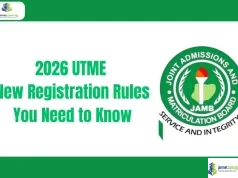Learn how to master the Elaboration Study Technique to pass your exams. Discover simple strategies to deepen your understanding and improve long-term retention of any subject.


In the quest for academic excellence, many students fall into the trap of passive learning. They spend hours re-reading notes, highlighting textbooks, and watching lectures, only to find that the information does not stick. The key to true mastery is not just seeing the information but about making it your own.

Join our Telegram Channel for Instant Scholarship Updates
This is where the Elaboration Technique comes in. It is a powerful learning strategy that transforms how your brain processes new information, helping you build a deeper, more resilient understanding that is essential for passing exams with flying colors.
What is the Elaboration Technique?
The Elaboration Technique is the process of connecting new information to existing knowledge. Instead of simply memorizing a fact, you ask yourself “how” and “why” it works, and then you relate it to something you already know or understand.
This is a form of active learning that forces your brain to create a rich network of connections. Think of your mind as a city. Passive learning is like adding a new, isolated building. You know it is there, but it is hard to get to. Elaboration, on the other hand, is like building new roads and bridges that connect the new building to the entire city, making it easy to access from multiple directions.
Common Elaboration Strategies
Elaboration is not a single action but a collection of mental strategies. By actively using these methods, you can build a more robust understanding of any subject.
- Questioning: Ask yourself “how,” “why,” “what if,” and “what is the purpose of this?” These questions force you to go beyond surface-level facts.
- Creating Analogies: Compare a new concept to something familiar. For example, comparing a computer’s CPU to the brain of a person or a company’s CEO.
- Connecting to Prior Knowledge: Actively link new information to concepts you have already learned in the same class or a different subject. This builds a rich web of interconnected ideas.
- Visualizing: Create a mental picture or diagram of a process or concept. If you are learning about the water cycle, picture a diagram with arrows showing each stage: evaporation, condensation, and precipitation.
- Explaining to Others: A classic strategy is the Feynman Technique, where you try to explain a concept simply to someone else. If you can explain it without using complex jargon, you truly understand it. If you cannot, you have found a gap in your knowledge.
How Elaboration Works (The Science Behind It)
The effectiveness of this technique is rooted in cognitive science. When you elaborate, you are creating a complex mental model or schema. This process involves:
- Meaningful Encoding: Your brain does not store information in a linear, file-cabinet manner. It stores it in a web of interconnected ideas. By elaborating, you encode the new information with meaning, attaching it to a larger network of knowledge. This makes the information more durable and less likely to be forgotten.
- Creating Multiple Retrieval Pathways: The more connections you create, the more “routes” you have to retrieve the information. On an exam, if one pathway is blocked by stress or a tricky question, you can use another connection to access the answer. This is why students who elaborate are less likely to experience a “blank mind” during a test.
- Deepening Conceptual Understanding: Elaboration moves you from a shallow, surface-level understanding to a deep, conceptual one. It forces you to think about the underlying principles, which is crucial for tackling complex problems and applying your knowledge to new scenarios.
Benefits of Using The Elaboration Technique
Using the Elaboration Technique can dramatically improve your performance on exam success for several key reasons:
- It Improves Long-Term Retention: Rote memorization can help you recall information for a short period, but it is not effective for long-term retention. Elaboration builds strong, lasting memories that stay with you long after the exam is over.
- It Enhances Critical Thinking: Exams often test your ability to apply knowledge, not just recall it. Elaboration forces you to think critically about the material, preparing you for higher-order questions that require analysis, synthesis, and evaluation.
- It Boosts Problem-Solving Skills: By understanding the underlying “why,” you can more easily apply a concept to new problems. You will be able to identify the correct approach even when a question is phrased differently from what you practiced.
- It Reduces Test Anxiety: When you truly understand the material and have multiple ways to access it, you feel more confident and less anxious. This confidence allows you to think clearly and perform at your best.
A Step-by-Step Guide to Applying the Elaboration Technique
You can start using this powerful technique today. Here is how to integrate elaboration into your study routine:
- Understand the Core Concept: Before you can elaborate, you need a basic grasp of the new information. Read a chapter, watch a lecture, or review a set of notes to get a foundational understanding.
- Ask the “How” and “Why” Questions: This is the heart of the technique. As you encounter a new fact or concept, do not just accept it. Actively question it:
- Why does this happen?
- How is this process carried out?
- What is the significance of this event?
- Connect to What You Already Know: Explicitly link the new concept to your existing knowledge base. This can be a related topic from another class, a personal experience, or a concept you learned in a previous chapter.
- Example: When learning about the concept of gravity, you could relate it to the personal experience of throwing a ball and watching it fall back to the ground.
- Create an Analogy or Metaphor: The ability to explain a complex idea in simple terms is a sign of true understanding. Create an analogy or a metaphor that compares the new concept to something familiar.
- Example: Comparing the circulatory system to a highway network where blood is the traffic and the heart is the central station.
- Explain it to Someone Else (The Feynman Technique): A fantastic way to elaborate is to teach the concept to someone else—a friend, a family member, or even yourself in the mirror. If you can explain it simply, you understand it. If you stumble, you have identified a knowledge gap that needs more work.
Examples of Elaboration in Different Subjects
To make this technique concrete, here is how it can be applied to different subjects:
- Biology: Instead of memorizing that mitosis is “cell division,” elaborate on it. How does a cell divide? Why does it need to divide? You could create an analogy: “Mitosis is like a single mother cell creating two identical twin daughter cells. The first mother cell makes a copy of all its chromosomes and then splits itself evenly in two.”
- History: When learning about the Industrial Revolution, do not just memorize the dates. Ask: Why did it start in England? How did new inventions like the steam engine change society? You could connect it to modern times by comparing the rapid technological change of that era to the rise of artificial intelligence today.
- Mathematics: Instead of just memorizing the formula for the area of a triangle (), elaborate on it. Why is it one-half of the base times the height? You could visualize it by drawing a rectangle and showing how a triangle takes up exactly half of its area.
- Literature: When analyzing a character in a novel, do not just list their traits. Ask: Why does this character behave this way? How do their past experiences influence their actions? You could connect their motivations to a real person you know or a historical figure.
Tips for Effective Elaboration
- Be Patient: Elaboration is harder than simple re-reading. It requires mental effort, and it may feel slow at first. Trust the process; the struggle is a sign that you are building stronger memory pathways.
- Write it Down: Writing down your questions, connections, and analogies can help you organize your thoughts and reinforce the learning process. You can also use effective note-taking methods like the Cornell Method to organize your elaboration.
- Combine with Other Techniques: Elaboration works best when combined with other active learning strategies. For example, you can use the Pomodoro Technique to stay focused, and you can alternate between subjects using the Interleaving Technique to build stronger connections across topics.
By making elaboration a central part of your study routine, you will move from being a passive consumer of information to an active builder of knowledge. This not only prepares you for exams but also cultivates the critical thinking and problem-solving skills that will serve you well for a lifetime. For more great strategies, check out these other study tips.
Frequently Asked Questions
1. Is elaboration only for deep subjects like science? No, elaboration works for all subjects, from mathematics and science to history and literature. The goal is always the same: to connect new information with what you already know, regardless of the topic.
2. How is elaboration different from simple summarization? Summarization condenses existing information, while elaboration expands upon it by adding new connections, meanings, and examples. Summarizing helps you recall the main points, while elaborating helps you understand the deeper relationships between them.
3. Does it take a lot of time? While elaboration requires more mental effort than passive review, it is more efficient in the long run. By building stronger memories and a deeper understanding, you will spend less time relearning the same material later on.
4. Can I use elaboration with flashcards? Yes, flashcards are a great tool for elaboration. Instead of just trying to recall the definition, use the cue on the flashcard to ask yourself “how” and “why” questions about the concept on the back.
5. What if I do not have existing knowledge to connect to? That is perfectly okay. You can still elaborate by connecting small pieces of the new information to each other. For example, if you are learning a new historical event, relate the names of the people to the events they participated in and the dates they occurred.
6. Can I do this with a group? Absolutely. Explaining a concept to a study partner or group is one of the most powerful forms of elaboration. It forces you to organize your thoughts and clarify any areas where your understanding is weak.
7. Is it better than spaced repetition? They are complementary, not competing techniques. Spaced repetition helps you remember when to review information, while elaboration helps you make that review process more effective and meaningful.
8. How do I know if I am elaborating correctly? If you can explain a complex concept in simple terms to someone who has no prior knowledge of the topic, you are likely doing it correctly. The key is clarity, not complexity.
9. Does elaboration work for all learning styles? Yes, elaboration is a versatile technique that can be adapted to many learning styles. Visual learners can use diagrams, auditory learners can explain concepts aloud, and kinesthetic learners can use hands-on examples or movements to aid their understanding.
10. What is the most important part of the Elaboration Technique? The most important part is the active questioning. By consistently asking “how” and “why,” you force your brain to engage with the material on a deeper level, transforming passive information into a part of your own knowledge base.













